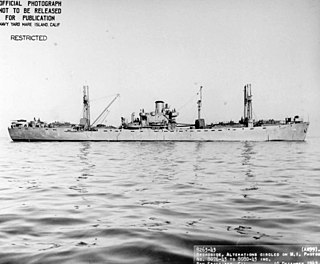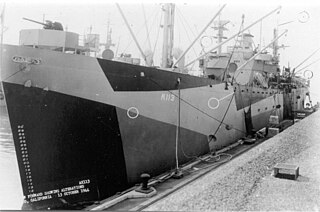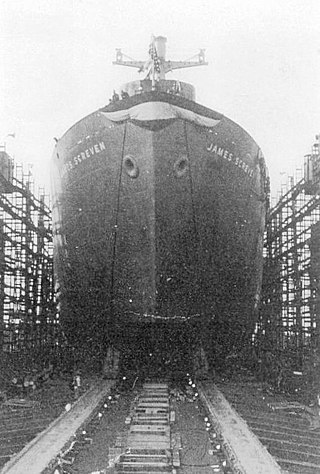
USS Altamaha (AVG-18/ACV-18/CVE-18) was an escort aircraft carrier in the United States Navy during World War II. She was named for the Altamaha River in Georgia.

USS Lynx (AK-100) was a Crater-class cargo ship commissioned by the US Navy for service in World War II. Lynx was the third US Navy vessel to bear the name, but unlike previous ships this one was named after the constellation Lynx. She was responsible for delivering troops, goods and equipment to locations in the Asiatic-Pacific Theater.

USS Arided (AK-73), a Crater-class cargo ship, is the only ship of the US Navy to have this name. She was named after Arided, the other name of Deneb, the alpha star of constellation Cygnus.

USS Kitty Hawk (APV-1/AKV-1), formerly SS Seatrain New York, was a cargo ship that was converted into an aircraft transport during World War II.

USS Crater (AK-70) was the lead ship of her class of converted liberty ship cargo ships in the service of the US Navy in World War II. She was first named after John James Audubon, an American ornithologist, naturalist, and painter. She was renamed and commissioned after the constellation Crater, she was the only ship of the Navy to bear this name.

USS Aludra (AK-72) was a Crater-class cargo ship in the service of the US Navy in World War II. Named after the star Aludra in the constellation Canis Major, it was the first ship of the Navy to bear this name.

The USS Alnitah (AK-127) was a Crater-class cargo ship in the service of the US Navy in World War II. Named a spelling variation of the star Alnitak in the constellation Orion, it was the only ship of the Navy to bear this name.

USS Alcyone (AKA-7) was an Arcturus-class attack cargo ship named after Alcyone, the brightest star in the star cluster Pleiades. She served as a commissioned ship for five years and one month.

USS Alchiba (AKA-6) was an Arcturus-class attack cargo ship of the United States Navy, named after Alchiba, a star in the constellation Corvus. She served as a commissioned ship for 4 years and 7 months.

USS Aldebaran (AF-10), the lead ship of her class of stores ship is the only ship of the United States Navy to have this name. She is named after Aldebaran, a star of the first magnitude in the constellation Taurus.

USS Wharton (AP-7) was a troop transport in the service of the United States Navy during World War II. The ship was originally an Emergency Fleet Corporation Design 1029 type built for the United States Shipping Board. The ship was laid down as Manmasco but renamed and launched as Sea Girt then completed September 1921 as Southern Cross. The ship was first allocated by the United States Shipping Board to the Munson Steamship Line until purchased by the line in 1925. Munson operated the Southern Cross in the South American trade from 1921 until 1938 when the ship was sold at a Marshall's sale and taken over by the United States Maritime Commission which paid the full mortgage claim.

USS Auriga (AK-98) was an Auriga-class cargo ship, the only ship in her class, commissioned by the U.S. Navy for service in World War II, named after the constellation Auriga. She was responsible for delivering troops, goods and equipment to locations in the war zone.

USS Bootes (AK-99) was a Crater-class cargo ship commissioned by the US Navy for service in World War II. She was named after the constellation Boötes. She was responsible for delivering troops, goods and equipment to locations in the Asiatic-Pacific Theater.

USS Sculptor (AK-103) was a Crater-class cargo ship commissioned by the US Navy for service in World War II. Sculptor was named after the constellation Sculptor. She was responsible for delivering troops, goods and equipment to locations in the Asiatic-Pacific Theater.

USS Alkes (AK-110) was a Crater-class cargo ship commissioned by the US Navy for service in World War II, named after Alkes, a star in the Crater constellation. She was responsible for delivering troops, goods and equipment to locations in the war zone.

USS Rutilicus (AK-113) was a Crater-class cargo ship commissioned by the US Navy for service in World War II. She was responsible for delivering troops, goods and equipment to locations in the Asiatic-Pacific Theater.
USS Alderamin (AK-116) was a Crater-class cargo ship commissioned by the U.S. Navy for service in World War II, named after Alderamin, the alpha star in constellation Cepheus. She was responsible for delivering troops, goods and equipment to locations in the war zone.
USS Zaurak (AK-117) was a Crater-class cargo ship commissioned by the U.S. Navy for service in World War II. She was responsible for delivering troops, goods and equipment to locations in the war zone.

USS Shaula (AK-118) was a Crater-class cargo ship, converted from a Liberty Ship, commissioned by the US Navy for service in World War II. She was first named after James Screven, an American general during the American Revolutionary War. She was renamed and commissioned after Shaula, the second-brightest star system in the constellation of Scorpius. She was responsible for delivering troops, goods and equipment to locations in the war zone.

USS George F. Elliott (AP-105) was a cargo liner built for the Mississippi Shipping Company as SS Delbrasil for operation between New Orleans and the east coast of South America in 1939 by its operator, Delta Line. The ship entered that service and operated until taken over by the War Shipping Administration (WSA) on 28 April 1942 for operation by Delta Line acting as WSA's agent. On 25 August 1943 WSA allocated the ship to the Navy for conversion to a troop transport commissioned and operated by the Navy for the duration of the war. Ownership of the ship was transferred from Mississippi Shipping to WSA on 4 February 1944 while under Navy operation and was retained until sale to American South African Lines on 22 December 1948. The ship was renamed African Endeavor until returned as a trade in to the Maritime Commission on 22 September 1960 for layup in the James River reserve fleet and later sold to Boston Metals for scrapping.


















